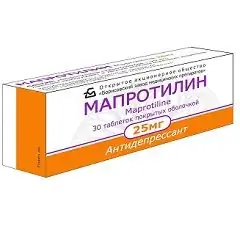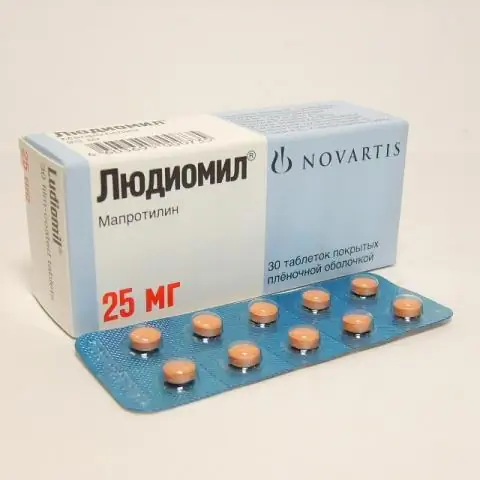- Author Rachel Wainwright [email protected].
- Public 2023-12-15 07:39.
- Last modified 2025-11-02 20:14.
Maprotiline
Maprotiline: instructions for use and reviews
- 1. Release form and composition
- 2. Pharmacological properties
- 3. Indications for use
- 4. Contraindications
- 5. Method of application and dosage
- 6. Side effects
- 7. Overdose
- 8. Special instructions
- 9. Application during pregnancy and lactation
- 10. Use in childhood
- 11. In case of impaired renal function
- 12. For violations of liver function
- 13. Use in the elderly
- 14. Drug interactions
- 15. Analogs
- 16. Terms and conditions of storage
- 17. Terms of dispensing from pharmacies
- 18. Reviews
- 19. Price in pharmacies
Latin name: Maprotiline
ATX code: N06AA21
Active ingredient: Maprotiline (Maprotiline)
Manufacturer: JSC "Borisov Plant of Medical Products" (JSC "BZMP") (Republic of Belarus)
Description and photo update: 2019-09-07

Maprotiline is an antidepressant.
Release form and composition
Dosage form - coated tablets: round, biconvex, white (in a cardboard box 3 cell contour packs of 10 tablets and instructions for the use of Maprotiline).
Composition of 1 tablet:
- active substance: maprotiline hydrochloride - 25 mg;
- auxiliary components: gelatin, anhydrous colloidal silicon dioxide, calcium hydrogen phosphate dihydrate, corn starch, lactose monohydrate, magnesium stearate, talc, Opadray II (polyvinyl alcohol, talc, macrogol 3350, titanium dioxide E171).
Pharmacological properties
Pharmacodynamics
Maprotiline is a tetracyclic antidepressant, a non-selective monoamine reuptake inhibitor that also has the same therapeutic characteristics as tricyclic antidepressants.
The mechanism of action of the drug is due to its ability to exert a pronounced inhibitory effect on the reuptake of norepinephrine by presynaptic neurons of the cerebral cortex. At the same time, the inhibition of serotonin reuptake is extremely insignificant.
Maprotiline has a weak or moderate affinity for central alpha1-adrenergic receptors. It significantly inhibits histamine H1 receptors. It has a moderate anticholinergic effect.
With prolonged use of the drug, the mechanism of its action may be affected by changes in the functional state of the neuroendocrine system (melatonin, growth hormone, endorphinergic system) and / or the system of neurotransmitters (serotonin, norepinephrine, gamma-aminobutyric acid).
Pharmacokinetics
After a single oral administration of maprotiline, hydrochloride is completely absorbed in the gastrointestinal tract. Absolute bioavailability averages 66-70%.
The maximum plasma concentration (C max) after taking a dose of 50 mg is reached within 8 hours and is 48-150 nmol / l. With long-term administration in a daily dose of 150 mg, the equilibrium concentration is reached in the second week and is 320-1270 nmol / l, regardless of whether the entire dose is taken at once or divided into 3 doses. The values of the equilibrium concentration have a linear dependence on the received dose of the drug, while in individual patients they can vary significantly.
The distribution coefficient of maprotiline between plasma and blood is 1.7. The average value of the apparent volume of distribution is 23-27 l / kg. Plasma proteins bind approximately 88-90%.
Maprotiline undergoes intensive metabolism; only 2-4% is excreted unchanged in the urine. The main metabolite is a desmethyl derivative with pharmacological activity. Other metabolites are formed due to methoxylation and / or hydroxylation and are excreted as conjugates in the urine.
The half-life (T 1/2) of the drug is 43-45 hours. The average total clearance is 510-570 ml / min.
After taking a single dose, the drug is excreted from the body within 21 days: ⅔ - with urine (in the form of conjugates and unchanged), ⅓ - with feces.
Pharmacokinetics in special cases:
- old age (over 60 years): the equilibrium concentration of the drug in the blood and the half-life increase, therefore the dose of Maprotiline should be reduced by 2 times;
- renal function: in patients with creatinine clearance (CC) 24-37 ml / min and normal liver function, renal excretion and T 1/2 change slightly. The excretion of metabolites by the kidneys also decreases, but this is compensated by an increase in excretion in the bile.
Indications for use
Maprotiline is used to treat depressive disorders.
Contraindications
Absolute:
- diseases accompanied by convulsive syndrome or a decrease in the seizure threshold (for example, brain damage of various etiologies, alcoholism);
- acute alcohol poisoning, psychotropic or hypnotic drugs;
- mania, acute delirium;
- delayed outflow of urine (for example, with diseases of the prostate gland);
- serious untreated blood supply disorders;
- severe renal / liver dysfunction;
- paralytic intestinal obstruction;
- pyloric stenosis;
- angle-closure glaucoma;
- intracardiac conduction disorders (blockade), acute stage of myocardial infarction;
- concomitant use of antiarrhythmic drugs (eg, quinidine, propafenone);
- co-administration of monoamine oxidase inhibitors (MAO);
- lactation period;
- age up to 18 years;
- cross-sensitivity to tricyclic antidepressants;
- hypersensitivity to any component of the drug.
Relative (Maprotiline tablets can be used after assessing the benefits and risks):
- the combined use of drugs that lower the threshold of seizure activity (for example, phenothiazines);
- cardiovascular diseases (arrhythmia, coronary heart disease, history of myocardial infarction);
- increased intraocular pressure;
- pregnancy;
- elderly age.
Maprotiline, instructions for use: method and dosage
Maprotiline tablets should be taken orally, swallowed whole with sufficient water.
Recommended dosage regimens:
- moderate to moderate depression (especially in outpatients): 25 mg 1-3 times a day or 25-75 mg 1 time a day, depending on the symptoms and response to treatment;
- severe depression (especially in inpatients): 25 mg 3 times a day or 75 mg 1 time a day. If necessary, the daily dose is gradually increased to a maximum of 150 mg (in one or more doses);
- other depressive disorders: 10 mg 3 times a day or 25 mg 1 time a day. Further, if necessary, the dose is gradually increased to 25 mg 3 times a day or 75 mg 1 time a day.
The maximum daily dose of Maprotiline is 150 mg.
Correction of the dosage regimen is recommended for elderly patients. Treatment begins with a dose of 10 mg 3 times a day or 25 mg 1 time a day. Further, as necessary, the dose is gradually increased to 25 mg 3 times a day or 75 mg 1 time a day.
During the treatment period, the doctor can change the dose of Maprotiline depending on the patient's condition and individual reaction to the drug. For example, a decrease in the daily dose and an increase in the evening dose may be recommended, or the appointment of a total daily dose in 1 dose.
After a significant improvement in the condition, an attempt can be made to reduce the dose. However, in case of repeated worsening of symptoms, the dose should be increased to the initial one.
The goal of treatment is to achieve the maximum therapeutic effect while taking the lowest dose. This is especially important in elderly patients, since they usually have instability of the autonomic nervous system and a more pronounced reaction to Maprotiline.
The sedative effect appears already in the first days of treatment. However, it takes 1-3 weeks to achieve the expected antidepressant effect.
Do not sharply reduce the dose or completely cancel Maprotiline. A gradual change in the dose towards a decrease is required, up to a complete cessation of admission.
Side effects
- from the central and peripheral nervous system: very often - headache, myoclonus, dizziness, tremor, drowsiness; often - impaired attention, memory loss, dysarthria, paresthesia, sedation; rarely - ataxia, akathisia, convulsions; very rarely - impaired coordination of movements and changes in taste, dyskinesia, fainting;
- from the side of the psyche: often - agitation, sleep disturbance, anxiety, anxiety, nightmares, insomnia, manic disorders, increased symptoms of depression, impaired libido; rarely - delirious disorders, hyperexcitability, depression of consciousness of varying degrees, hallucinations (mainly in elderly patients); very rarely - depersonalization, activation of psychosis symptoms;
- on the part of the cardiovascular system: often - a feeling of palpitations, sinus tachycardia, orthostatic hypotension, a feeling of heat (hot flashes); rarely - arrhythmias; very rarely - ventricular tachycardia, an increase in the QT interval, ventricular fibrillation, purpura, bidirectional fusiform ventricular tachycardia, intracardiac conduction disorders (including changes in the PQ interval, expansion of the QRS complex, bundle branch block);
- from the gastrointestinal tract: very often - dry mouth; often - abdominal discomfort, nausea, constipation, vomiting; rarely diarrhea; very rarely - stomatitis, hepatitis (including accompanied by jaundice);
- on the part of the skin: often - rash, allergic dermatitis, urticaria, hyperhidrosis, photosensitization; very rarely - itching, alopecia, cutaneous vasculitis, toxic epidermal necrolysis, Stevens-Johnson syndrome, erythema multiforme;
- from the respiratory system: very rarely - allergic alveolitis (may be accompanied by eosinophilia, nasal congestion, bronchospasm);
- from the endocrine system and metabolism: often - increased appetite; sometimes - increased body weight; very rarely - syndrome of inappropriate secretion of antidiuretic hormone;
- from the senses: often - accommodation disorders, blurred vision; very rarely - tinnitus;
- on the part of the hematopoietic system: very rarely - agranulocytosis, thrombocytopenia, eosinophilia, leukopenia;
- from the musculoskeletal system: often - muscle weakness;
- on the part of the excretory and reproductive system: often - urination disorders, erectile dysfunction; very rarely - galactorrhea, breast hypertrophy, urinary retention;
- others: very rarely - caries.
In the case of a rapid dose reduction or abrupt withdrawal of Maprotiline, the following symptoms may develop: abdominal pain, nausea, diarrhea, vomiting, headache, anxiety, increased excitability, insomnia, increased or relapse of depressive mood disorders.
Overdose
Symptoms are similar to those of an overdose of tricyclic antidepressants. Neurological and cardiovascular disorders predominate. The drug is not used in pediatrics, therefore, cases of taking Maprotiline by children are regarded as a serious and fatal accident, regardless of the dose.
Overdose signs usually develop within 4 hours, reaching maximum severity in a day. Given the delayed absorption (anticholinergic effect), hepatoenteric recirculation, and the long half-life of maprotiline, the risk to the patient's life persists for 4-6 days.
Symptoms of a maprotiline overdose:
- from the central nervous system: anxiety, drowsiness, agitation, ataxia, muscle stiffness, convulsions, choreoathetoid movements, increased reflexes, stupor, coma;
- on the part of the cardiovascular system: a marked decrease in blood pressure, arrhythmia, tachycardia, impaired intracardiac conduction, heart failure, shock; very rarely - cardiac arrest;
- others: cyanosis, fever, excessive sweating, mydriasis, vomiting, anuria or oliguria, respiratory depression.
There is no specific antidote for maprotiline. Treatment is aimed at eliminating developing disorders and maintaining the vital functions of the body. The patient is hospitalized and closely monitored for at least 72 hours.
As a first aid measure, you should rinse the stomach as soon as possible, induce vomiting and take activated charcoal. If the patient is unconscious, tracheal intubation and gastric lavage are indicated.
Treatment includes modern methods of intensive care with constant monitoring of heart function, electrolyte and blood gas composition. If indicated, artificial lung ventilation, anticonvulsant therapy and other resuscitation methods are performed. Physostigmine is not recommended because it can cause asystole, severe bradycardia and seizures. Hemodialysis and peritoneal dialysis are ineffective.
special instructions
With long-term use of Maprotiline in high doses, it is necessary to monitor the electrocardiogram and other functional parameters of the heart, especially in patients with cardiovascular problems and the elderly. If there is a tendency to orthostatic hypotension, regular monitoring of blood pressure is indicated.
Maprotiline may have a negative effect on mental reactions, especially with the simultaneous use of drugs that have a depressive effect on the central nervous system (CNS), or alcohol.
Influence on the ability to drive vehicles and complex mechanisms
During the period of treatment, one should not drive vehicles and perform potentially hazardous work that requires precision of movements, increased attention and speed of reactions.
Application during pregnancy and lactation
In experimental studies, it was found that maprotiline hydrochloride does not have teratogenic and mutagenic effects, does not impair fertility, and does not cause damage to the fetus. However, the experience of using the drug during pregnancy is not enough. There are isolated reports of possible undesirable disorders in pregnant women who received maprotiline. In this regard, the drug is contraindicated during pregnancy, except in cases where the benefits of therapy are definitely higher than the potential risks.
In newborns, whose mothers received maprotiline during pregnancy, it is possible to develop shortness of breath, irritability, lethargy, a pronounced decrease in blood pressure, tachycardia, hypothermia, nervous excitement, and seizures. In this regard, the drug should be canceled at least 7 weeks before the expected date of delivery (if the patient's condition allows).
Maprotiline passes into breast milk. After taking the drug in a daily dose of 150 mg for 5 days in breast milk, the concentration of the active substance exceeds that in plasma by 1.3-1.5 times. Although there is no information indicating the development of adverse reactions in infants, it is recommended to refrain from taking Maprotiline during lactation or to refuse breastfeeding.
Pediatric use
In children under 18 years of age, the safety and efficacy of Maprotiline has not been studied, therefore, the appointment of the drug is contraindicated in this age group.
With impaired renal function
In severe functional disorders of the kidneys, an antidepressant is contraindicated. For mild to moderate disorders, there is no need to change the treatment regimen.
For violations of liver function
In severe functional disorders of the liver, an antidepressant is contraindicated. For mild to moderate disorders, there is no need to change the treatment regimen.
Use in the elderly
Elderly patients should be treated with caution. Correction of dosage regimen is required.
Drug interactions
Maprotiline should not be used in conjunction with MAO inhibitors, since this combination raises the risk of tremor, hyperpyrexia, delirium, generalized clonic seizures, and even death. Intervals of at least 14 days should be observed between doses of these drugs.
Maprotiline should not be used in combination with antiarrhythmic drugs such as quinidine and propafenone. When using such combinations, mutual enhancement of the action of drugs is possible.
The effect of Maprotiline on concomitantly used drugs:
- enhances the cardiovascular effects of sympathomimetic drugs such as ephedrine, isoprenaline, phenylephrine, epinephrine and norepinephrine, including when they are included in nasal drops and local anesthetics (for example, used in dentistry). In such situations, patients require careful selection of the dose of drugs and monitoring, including control of blood pressure and heart rate;
- can reduce and even completely eliminate the hypotensive effect of adrenergic drugs such as reserpine, alpha-methyldopa, betanidine, guanethidine. In this regard, for the treatment of arterial hypertension, drugs of other classes should be prescribed, for example, beta-blockers, vasodilators, diuretics. In addition, it must be borne in mind that abrupt withdrawal of Maprotiline can cause a pronounced decrease in blood pressure;
- enhances the effect on the pupil of the eye, bladder, intestines and the central nervous system of drugs with anticholinergic properties, such as atropine, phenothiazines, biperiden, antihistamines and antiparkinsonian drugs;
- can increase the concentration of carbamazepine and phenytoin, increase their side effects;
- enhances the anticoagulant effect of coumarin derivatives, which requires careful monitoring of the level of prothrombin in plasma and, if necessary, adjust the dose of the anticoagulant;
- potentiates the hypoglycemic effect of insulin and sulfonylurea derivatives, therefore, in patients with diabetes mellitus, blood glucose levels should be carefully monitored both during the period of using maprotiline and after its withdrawal;
- enhances the effect of drugs that have a depressing effect on the central nervous system, including barbiturates and ethanol.
Effect of other drugs on maprotiline:
- the main tranquilizers can increase its plasma concentration, lower the seizure threshold and cause the development of seizures;
- inducers of microsomal liver enzymes (oral contraceptives, barbiturates, carbamazepine, phenytoin) increase its metabolism, which can reduce the antidepressant effect. Dose adjustments should be made if necessary;
- methylphenidate and beta-blockers, which are characterized by significant biotransformation (for example, propranolol), can increase its plasma concentration and enhance its effects. When prescribing such a combination, the concentration of maprotiline should be monitored and the dose adjusted if necessary;
- the antipsychotic thioridazine may increase the risk of severe arrhythmias;
- fluoxetine and fluvoxamine can significantly increase its plasma concentration and, as a result, cause the development of undesirable reactions;
- benzodiazepines enhance sedation;
- cimetidine can increase the concentration in the blood and increase the frequency of adverse reactions (dry mouth, visual impairment), which requires a reduction in the dose of maprotiline.
Analogs
Maprotiline analogs are Adepress, Alventa, Amitriptyline, Asentra, Valdoxan, Velaksin, Dapfix, Zoloft, Clofranil, Lyudomil, Mirzaten, Paxil, Oprah, Prozac, Sancipam, Torin, Trittico, Umoral, Fevarin, Fluoxetsev, Eloxetin …
Terms and conditions of storage
Store in a dry, dark place at temperatures up to 25 ° C. Keep out of the reach of children.
Shelf life is 2 years.
Terms of dispensing from pharmacies
Dispensed by prescription.
Reviews about Maprotiline
Patients leave mostly positive reviews about Maprotiline: the drug increases vitality, eliminates symptoms of depression, and is well tolerated. Adverse reactions are rarely mentioned, usually an increase in body weight.
The disadvantages indicate a long period of development of the effect, up to 2 months.
Price for Maprotiline in pharmacies
Depending on the region of sale and the pharmacy network, the price for Maprotiline for a pack of 30 tablets can be 852-1108 rubles.

Maria Kulkes Medical journalist About the author
Education: First Moscow State Medical University named after I. M. Sechenov, specialty "General Medicine".
Information about the drug is generalized, provided for informational purposes only and does not replace the official instructions. Self-medication is hazardous to health!






